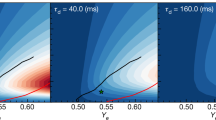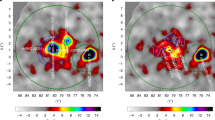Abstract
COLLISIONS between cosmic rays (energetic protons and α-particles) and carbon, nitrogen and oxygen in the interstellar medium have been considered1 to be the main source of lithium, beryllium and boron, through fragmentation of the larger nuclei. But this mechanism is unable to account for the observed Solar System abundances of the isotopes 7Li and 11B. The recent detection of an excess of γ-rays2 in the direction of the star-forming region in the Orion cloud has been interpreted3 as arising from the excitation of carbon and oxygen nuclei ejected from supernovae when they collide with the surrounding gas, which is primarily molecular and atomic hydrogen. Here we investigate the consequences of the two-body interactions of the ejected carbon and oxygen nuclei (and the α-particles ejected with them) with the hydrogen and helium in the surrounding gas, using a model developed previously4–6. We show that these interactions offer a way to make lithium, beryllium and boron that is independent of the abundance of heavy elements in the surrounding medium. Such supernova-driven interactions, combined with the effect of galactic cosmic rays, can explain the observed Solar System abundances of these light elements.
This is a preview of subscription content, access via your institution
Access options
Subscribe to this journal
Receive 51 print issues and online access
$199.00 per year
only $3.90 per issue
Buy this article
- Purchase on Springer Link
- Instant access to full article PDF
Prices may be subject to local taxes which are calculated during checkout
Similar content being viewed by others
References
Reeves, H. Rev. mod. Phys. 66, 193–216 (1994).
Bloemen, H. et al. Astr. Astrophys. 281, L5–L8 (1994).
Bykov, A. & Bloemen, H. Astr. Astrophys. 283, L1–L4 (1994).
Ramaty, R., Kozlovsky, B. & Lingenfelter, R. L. Astrophys. J. Suppl. Ser. 40, 487–526 (1979).
Ramaty, R., Kozlovsky, B. & Lingenfelter, R. L. Space Sci. Rev. 18, 341–388 (1975).
Murphy, R. J., Hua, X. M., Kozlovsky, B. & Ramaty, R. Astrophys. J. 351, 299–308 (1990).
Burrows, D. N., Singh, K. P., Nousek, J. A., Garmire, G. P. & Goog, J. Astrophys. J. 406, 97–111 (1993).
Weaver, T. M. & Woosley, S. E. Phys. Rep. 227, 65–96 (1993).
Woosley, S. E., Langer, N. & Weaver, T. A. Astrophys. J. 411, 823–839 (1993).
Brown, A. G. A., de Geus, E. J. & de Zeeuw, P. T. Astr. Astrophys. 289, 101–120 (1994).
Cunha, K. & Lambert, D. L. Astrophys. J. 426, 170–191 (1994).
Anders, E. & Grevesse, N. Geochim. cosmochim. Acta 53, 197–214 (1989).
Read, S. M. & Viola, V. E. Atomic Data and Nuclear Data Tables 31, 359–397 (1984).
Blocmen, H. et al. Astr. Astrophys. 139, 37–42 (1984).
Meneguzzi, M., Audouze, J. & Reeves, H. Astro. Astrophys. 15, 337–359 (1971).
Menegussi, M. & Reeves, H. Astr. Astrophys. 40, 99–110 (1975).
Spite, F. & Spite, M. in Origin and Evolution of the Elements, (eds Prantzos, N. Vangioni-Flam, E. & Cassé, M.) 201–211 (Cambridge Univ. Press, 1993).
Edvardsson, B. et al. Astr. Astrophys. (in the press).
Fields, B. D., Olive, K. A. & Schramm, D. N. Astrophys. J. (in the press).
Kozlovsky, B. & Ramaty, R. Astrophys. J. 191, L43–L44 (1974).
Ramaty, R., Kozlovsky, B. & Lingenfelter, R. E. Astrophys. J. Lett, (in the press).
Marti, K. & Lingenfelter, R. in Nuclei in the Cosmos (L'Apuila, Italy, in the press).
Vangioni-Flam, E., Cassé, M., Audouze, J. & Oberto, Y. Astrophys. J. 364, 568–572 (1990).
Cassé, M., Vangioni-Flam, E., Lehoucq, R. & Oberto, Y. in Nuclei in the Cosmos (L'Aquila, Italy, in the press).
Clayton, D. D. Nature 368, 222–224 (1994).
Ryan, S., Norris, I., Bessel, M. & Deliyannis, C. Astrophys. J. 388, 184–189 (1994).
Gilmore, G., Gustafsson, B., Edvardsson, B. & Nissen, P. E. Nature 357, 379–384 (1992).
Duncan, D., Lambert, D. & Lemke, M. Astrophys. J. 401, 584–595 (1992).
Author information
Authors and Affiliations
Rights and permissions
About this article
Cite this article
Cassé, M., Lehoucq, R. & Vangloni-Flam, E. Production and evolution of light elements in active star-forming regions. Nature 373, 318–319 (1995). https://doi.org/10.1038/373318a0
Received:
Accepted:
Issue Date:
DOI: https://doi.org/10.1038/373318a0
This article is cited by
-
The elemental abundance pattern in a galaxy at z = 2.626
Nature (2003)
Comments
By submitting a comment you agree to abide by our Terms and Community Guidelines. If you find something abusive or that does not comply with our terms or guidelines please flag it as inappropriate.



